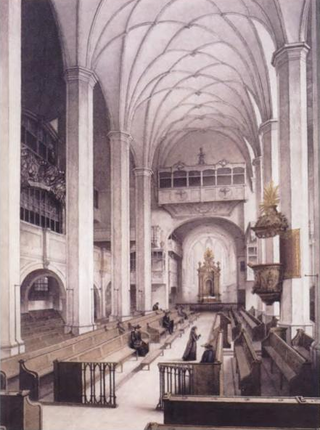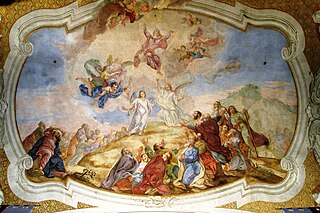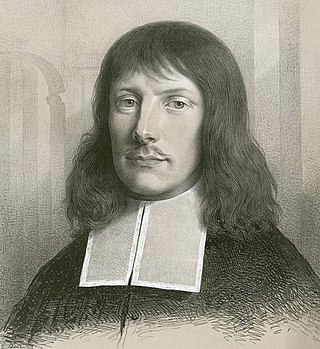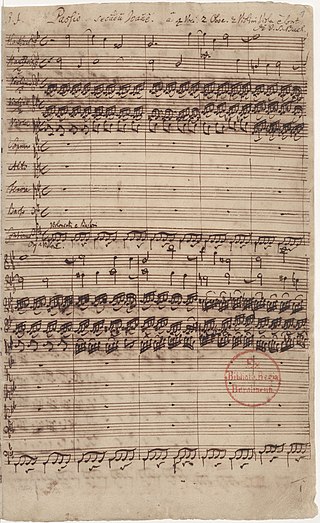Related Research Articles

Wir danken dir, Gott, wir danken dir, BWV 29, is a sacred cantata by Johann Sebastian Bach. He composed it in Leipzig in 1731 for Ratswechsel, the annual inauguration of a new town council, and first performed it on 27 August of that year. The cantata was part of a festive service in the Nikolaikirche. The cantata text by an unknown author includes in movement 2 the beginning of Psalm 75, and as the closing chorale the fifth stanza of Johann Gramann's "Nun lob, mein Seel, den Herren". Bach scored the work in eight movements for four vocal parts and a festive Baroque orchestra of three trumpets, timpani, two oboes, strings, an obbligato organ and basso continuo. The organ dominates the first movement Sinfonia which Bach derived from a Partita for violin. The full orchestra accompanies the first choral movement and plays with the voices in the closing chorale, while a sequence of three arias alternating with two recitatives is scored intimately.

Wachet auf, ruft uns die Stimme, BWV 140, also known as Sleepers Awake, is a church cantata by Johann Sebastian Bach, regarded as one of his most mature and popular sacred cantatas. He composed the chorale cantata in Leipzig for the 27th Sunday after Trinity and first performed it on 25 November 1731.

Ach Gott, vom Himmel sieh darein, BWV 2 is a chorale cantata composed by Johann Sebastian Bach for the second Sunday after Trinity in 1724. First performed on 18 June in Leipzig, it is the second cantata of his chorale cantata cycle. The church cantata is based on Martin Luther's 1524 hymn "Ach Gott, vom Himmel sieh darein", a paraphrase of Psalm 12.

Johann Sebastian Bach composed the church cantata Christ unser Herr zum Jordan kam, BWV 7, in Leipzig for the Feast of St. John the Baptist and led its first performance on 24 June 1724.

Johann Sebastian Bach composed the church cantata Es ist das Heil uns kommen her, BWV 9 in Leipzig for the sixth Sunday after Trinity and first performed it on 1 August 1734. It is a chorale cantata, based on the hymn "Es ist das Heil uns kommen her" by Paul Speratus. Bach composed the cantata to fill a gap in his chorale cantata cycle written for performances in Leipzig from 1724.

Jesu, der du meine Seele, BWV 78 is a church cantata of Johann Sebastian Bach. He composed the chorale cantata in Leipzig for the 14th Sunday after Trinity and first performed it on 10 September 1724. It is based on the hymn by Johann Rist.

Lobet Gott in seinen Reichen, BWV 11, known as the Ascension Oratorio, is an oratorio by Johann Sebastian Bach, marked by him as Oratorium In Festo Ascensionis Xsti, composed for the service for Ascension and probably first performed on 15 May 1738.

Johann Sebastian Bach composed the church cantata Es ist nichts Gesundes an meinem Leibe, BWV 25 in Leipzig for the 14th Sunday after Trinity and first performed it on 29 August 1723.

Johann Sebastian Bach composed the church cantata Wer Dank opfert, der preiset mich, BWV 17 in Leipzig for the fourteenth Sunday after Trinity and first performed it on 22 September 1726.

Johann Sebastian Bach composed the church cantata O Ewigkeit, du Donnerwort, BWV 20, in Leipzig for the first Sunday after Trinity and first performed it on 11 June 1724. Bach composed it when beginning his second year as Thomaskantor in Leipzig. It is the first cantata he composed for his second annual cycle which was planned to contain chorale cantatas, each based on a Lutheran hymn. The cantata is focused on Johann Rist's 1642 hymn "O Ewigkeit, du Donnerwort", with a chorale melody by Johann Schop. As usual for Bach's chorale cantatas to come in the cycle, selected hymn stanzas were retained while the others were paraphrased by a contemporary poet who transformed their ideas into a sequence of alternating recitatives and arias. For this cantata, the first stanza was used unchanged, and two more stanzas to conclude the cantata's two parts. The first part was performed before the sermon, the second part after the sermon. The first part is in seven movements, and the second part is in four movements.

Johann Sebastian Bach composed the church cantata Schwingt freudig euch empor, BWV 36, in Leipzig in 1731 for the first Sunday in Advent. He drew on material from previous congratulatory cantatas, beginning with Schwingt freudig euch empor, BWV 36c (1725). The Gospel for the Sunday was the Entry into Jerusalem, thus the mood of the secular work matched "the people's jubilant shouts of Hosanna". In a unique structure in Bach's cantatas, he interpolated four movements derived from the former works with four stanzas from two important Advent hymns, to add liturgical focus, three from Luther's "Nun komm, der Heiden Heiland" and one from Nicolai's "Wie schön leuchtet der Morgenstern". He first performed the cantata in its final form of two parts, eight movements, on 2 December 1731.
Notable recordings of Johann Sebastian Bach's St Matthew Passion (Matthäus-Passion) are shown below in a sortable table.

Herr Gott, Beherrscher aller Dinge, BWV 120.2, is a wedding cantata by Johann Sebastian Bach. He composed and first performed it in Leipzig, most likely in 1729.
The listing shows recordings of the Mass in B minor, BWV 232, by Johann Sebastian Bach. The selection is taken from the 281 recordings listed on the Bach Cantatas Website as of 2018, beginning with the first recording by a symphony orchestra and choir to match, conducted by Albert Coates. Beginning in the late 1960s, historically informed performances paved the way for recordings with smaller groups, boys choirs and ensembles playing period instruments, and eventually to recordings using the one-voice-on-a-vocal-part scoring first argued for by Joshua Rifkin in 1982.

Sie werden aus Saba alle kommen, BWV 65, is a church cantata by Johann Sebastian Bach. He composed it in 1724 in Leipzig for Epiphany and first performed it on 6 January 1724 as part of his first cantata cycle.

Sie werden euch in den Bann tun, BWV 183, is a church cantata by Johann Sebastian Bach. He composed it in Leipzig for Exaudi, the Sunday after Ascension, and first performed it on 13 May 1725. The work includes some unusual woodwind scoring, two oboes da caccia and two oboes d'amore.

Johann Sebastian Bach composed the church cantata Ach Herr, mich armen Sünder, BWV 135 in Leipzig for the third Sunday after Trinity and first performed it on 25 June 1724. It is the fourth chorale cantata from his second annual cycle, and is based on the hymn by Cyriakus Schneegass.

The structure of the St John Passion, BWV 245, a sacred oratorio by Johann Sebastian Bach first performed in Leipzig on Good Friday 1724, is "carefully designed with a great deal of musico-theological intent". Some main aspects of the structure are shown in tables below.

Chorale is the name of several related musical forms originating in the music genre of the Lutheran chorale:

Fallt mit Danken, fallt mit Loben, BWV 248IV, is a Christmas cantata by Johann Sebastian Bach, composed in 1734 as Part IV of his six-part Christmas Oratorio. Each part of the oratorio is a cantata, written for performance on one of the feast days of the Christmas period. Fallt mit Danken, fallt mit Loben is meant for the New Year's Day feast of the circumcision and naming of Jesus. Based on a libretto by an unknown author, it tells the naming of Jesus from the Nativity of Jesus, according to the Gospel of Luke.
References
- 1 2 "Johannes-Passion BWV 245 / Recordings - Part 2 / Complete Recordings 1950-1959". bach-cantatas.com. Retrieved 17 August 2015.
- 1 2 3 4 5 6 "Johannes-Passion BWV 245 / Recordings - Part 3 / Complete Recordings 1960-1969". bach-cantatas.com. Retrieved 17 August 2015.
- 1 2 "Johannes-Passion BWV 245 / Recordings - Part 4 / Complete Recordings 1970-1979". bach-cantatas.com. Retrieved 17 August 2015.
- 1 2 3 4 5 "Johannes-Passion BWV 245 / Recordings - Part 5 / Complete Recordings 1980-1989". bach-cantatas.com. Retrieved 17 August 2015.
- 1 2 3 4 5 "Johannes-Passion BWV 245 / Recordings - Part 6 / Complete Recordings 1990-1999". bach-cantatas.com. Retrieved 17 August 2015.
- 1 2 3 4 "Johannes-Passion BWV 245 / Recordings - Part 8 / Complete Recordings 2000-2009". bach-cantatas.com. Retrieved 17 August 2015.
- 1 2 "Johannes-Passion BWV 245 / Recordings - Part 9 / Complete Recordings 2010-2019". bach-cantatas.com. Retrieved 17 August 2015.